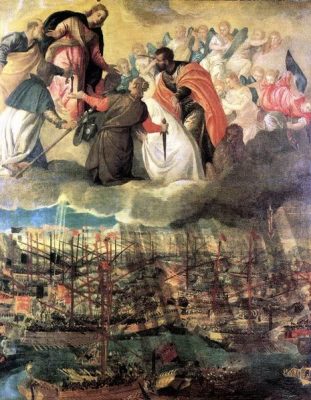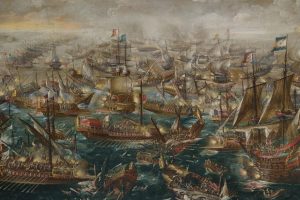On October 7, the Feast of Our Lady of the Rosary, more than on any other feast day, I feel especially emboldened in faith and hope, no matter what may be the anti-common sense, anti-life, anti-Christian news of the day! The reason is simple. The power of praying the Rosary was manifest in such a remarkable, historical and tangible way on this day, at the Battle of Lepanto, that Pope Pius V declared it to be a Feast in honor of Our Lady of Victory.
Subsequent popes altered the feast name to Our Lady of the Rosary to more fully reflect what was done (and what we can still do today) to achieve Our Lady’s victory as was done so many times throughout history, including most stunningly on October 7, 1571.
On this date a now-famous battle took place between Islamic and Christian forces that literally turned the tide for Christendom, against the long, relentless, ongoing, aggressive and ravishing conquest of Christian nation after nation by the Ottoman Turkish Islam empire. This was a serious endeavor aimed at stomping out Christianity. This was the Islamic conquest that turned Constantinople, a former seat of Christian Faith, into what today is known as the city of Istanbul.
On that day, in 1571, Pope Pius V asked all the faithful, throughout all of Christendom, to pray the Rosary for a favorable Christian outcome in a naval battle between the fresh, large fleet of the Islamic Ottoman Empire and the much smaller, exhausted-from-recent-battles Christian fleet. The battle took place near Lepanto, off southwestern Greece.

So powerful were the prayers of the Rosary requested of the faithful by Pope Pius V that even the rough soldiers on the decks of ships in the Christian fleet, led by the Don Juan of Austria, fasted, confessed and kneeled to pray the Rosary before engaging in battle.
In the Battle of Lepanto the newly formed Holy League—a navy culled together by Pope Pius V from among Christian nations to defend Christendom against the seemingly invincible Islam Turkish Ottoman Empire—fought a battle that historians consider to be THE decisive battle against the suffocating conquest of Christian nations by the Muslim empire.
But the Holy League Christian ships did not win the battle on their own. It would have been nearly impossible given the odds.
Yet during that remarkable battle, something miraculous happened…
An abbreviated section of Mr. Check’s article on the Battle of Lepanto captures the scene:
“It was at dawn on October 7, 1571, the Holy League rowed down the west coast of Greece and turned east into the Gulf of Patras. When the morning mist cleared, the Christians, rowing directly against the wind, saw the squadrons of the larger Ottoman fleet arrayed like a crescent from shore to shore, bearing down on them under full sail.
As the fleets grew closer, the Christians could hear the gongs and cymbals, drums and cries of the Turks. The men of the Holy League quietly pulled at their oars, the soldiers stood on the decks in silent prayer. Priests holding large crucifixes marched up and down the decks exhorting the men to be brave and hearing final confessions.
Then the Blessed Virgin intervened.
The wind shifted 180 degrees. The sails of the Holy League were filled with the Divine breath, driving them into battle. Now heading directly into the wind, the Turks were forced to strike their sails. The tens of thousands of Christian galley slaves who rowed the Turkish vessels felt the sharp sting of the lash summoning them up from under their benches and demanding they take hold of their oars and pull against the wind.
Don John knelt on the prow of Real and said a final prayer. Then he stood and gave the order for the Holy League’s battle standard, a gift from Pius V, to be unfurled. Christians up and down the battle line cheered as they saw the giant blue banner bearing an image of our crucified Lord.”
Many historical accounts of Battle of Lepanto report that a thick fog arose, causing confusion among the Muslim fleet so that it mistakenly attacked its own ships. Many historical accounts also mention a vision of Our Lady holding the Rosary which appeared in the clouds at some point during the battle, seen by many of those who were fighting. A portion of Mr. Check’s article continues below:
“The fleets engaged at midday. The first fighting began along the Holy League’s left flank, where many of the smaller, swifter Turkish galleys were able to maneuver around Agostin Barbarigo’s inshore flank. The Venetian admiral responded with a near impossibility: He pivoted ….
…The fighting lasted for five hours…but the Divine favored the Christians, and once the battle turned in their favor it became a rout. All but 13 of the nearly 300 Turkish vessels were captured or sunk and over 30,000 Turks were slain. Not until the First World War would the world again witness such carnage in a single day’s fighting….
The news of the victory made its way back to Rome, but the Pope was already rejoicing. On the day of the battle, Pius had been consulting with his cardinals at the Dominican Basilica of Santa Sabina on the Aventine Hill. He paused in the midst of their deliberations to look out the window. Up in the sky, the Blessed Mother favored him with a vision of the victory. Turning to his cardinals he said, “Let us set aside business and fall on our knees in thanksgiving to God, for he has given our fleet a great victory.”
Our Lady of Mercy and Grace, through our daily devotion to the Rosary, help us in business to be instruments of your Son’s peace, to bring charity in truth, and serve justice for all, especially for the unborn and elderly.
—This article was revised and updated from its original publication date of October 7, 2013 .
RELATED RESOURCES:
- I encourage you to read two of the best articles available on the Battle of Lepanto, one is written by Christopher Check, executive vice president of The Rockford Institute, who served for seven years as a field artillery officer in the U.S. Marine Corps, the father of four boys who lectures on topics in military and Church history. His original article appears in Catholic Answers’ This Rock magazine, and may be found here.
- The second article may be found in The New American here.
- Rosary 2018 Coast to Coast


